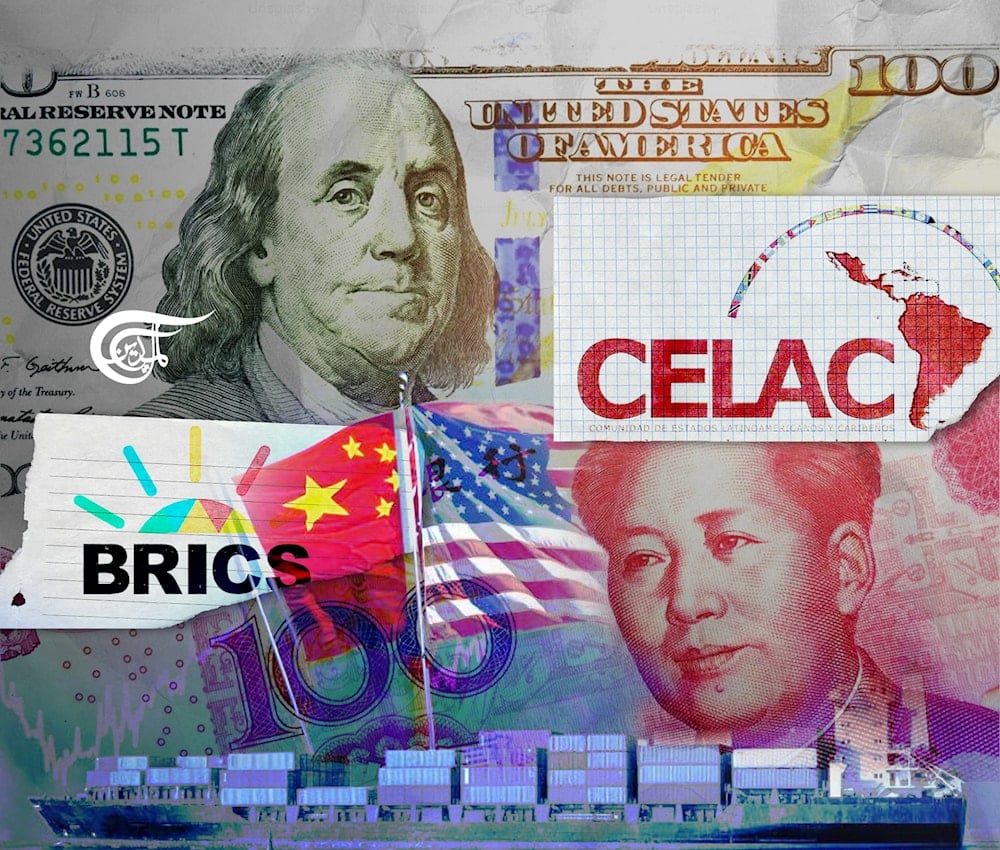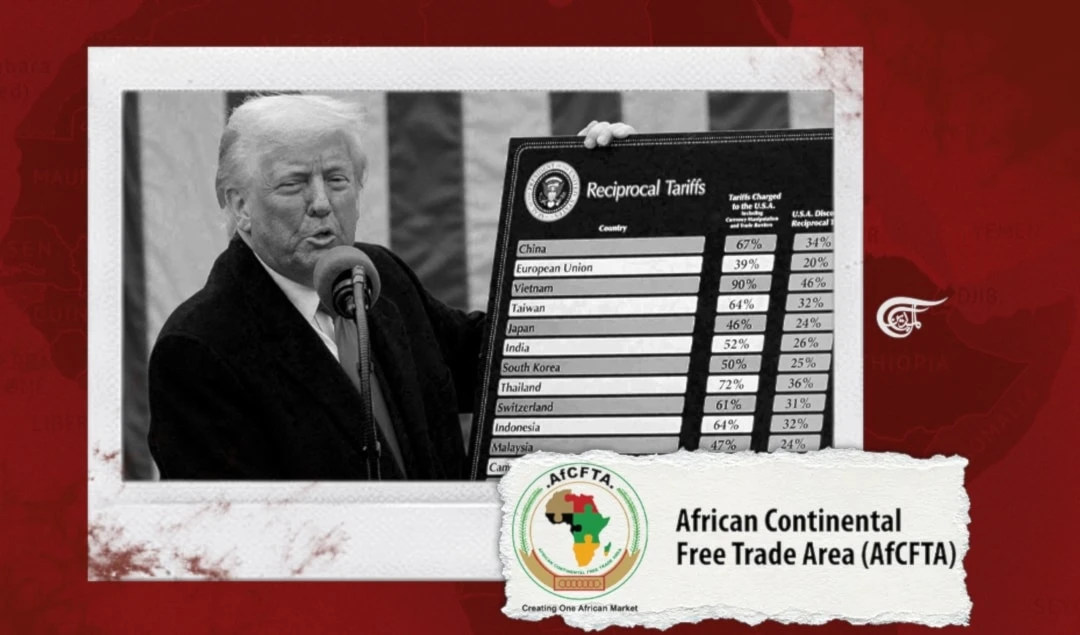Did the US pause the tariff escalation, sensing the shifting tides of de-dollarization?
Over 60 countries have either implemented or are in the process of implementing retaliatory tariffs on imports from the US, a decision that could have adversely affected cumulative US exports.
-

In the wake of his tariff diversification on imports, Trump encountered a series of challenges both domestically and internationally (Illustrated by Mahdi Rtail; Al Mayadeen English)
The US government suffered its first retreat in the trade war with its main import partners on Wednesday, April 9, when President Trump decided to postpone import duties on all countries except China for 90 days. The proposal is aimed at lessening trade friction, which has already created considerable disruptions in global trade markets.
However, analysts believe that the regional trade blocs formed in response to Trump's tariff measures in Europe, Africa, and Latin America will continue to exist despite the relaxation of import tariffs since the blanket import measures have harmed the US reputation and credibility.
Trump posted on X on Wednesday that he has allowed a 90-day pause and a 10% reciprocal tariff in response to over 75 countries' “successful trade talks” with minimal retaliation. He reduced duties, but not on China, in response to stock market falls.
The 10% duty is lower than Trump's prior tariffs of 20% for the European Union, 24% for Japan, and 25% for South Korea. Canada and Mexico will continue to face tariffs of up to 25%.
Why did Trump rescind his tariff measures?
In the wake of his tariff diversification on imports, Trump encountered a series of challenges both domestically and internationally. The stock and currency markets reacted negatively, while major economies began exploring alternatives to the dollar, a move that inadvertently bolstered the BRICS+ initiative for de-dollarization.
In a striking development, the global economy seemed to have pushed back against the tariffs imposed by President Trump, slated to come into effect early Wednesday, April 9. This reaction highlights the fact that the US president is not immune to market forces.
The trust of European financial markets in Washington’s financial stability has been undermined by President Trump's economic policies, imposing significant tariffs on imports from both allied and adversarial nations while also limiting the dollar funding necessary for the European banking sector during times of market stress.
A Reuters report last week suggested that European banks are under pressure to shift away from the US dollar toward other currencies. They expect this transition to invigorate the BRIC+ de-dollarization initiative. The European bankers contend that Trump’s isolationist policies are currently acting as a catalyst for this trend. Their perspective suggests that revoking the “Federal Swap Line” could potentially accelerate the global trend toward de-dollarization.
However, they noted that financial stress would also permeate the US financial system, with potential spillover effects including "a fire sale of US assets." The analysts noted that although the Fed operates independently, the US administration can exert indirect influence through moral suasion and by appointing members to the Fed governing board. The US might, in theory, utilize its swap lines selectively, although the possibility remains speculative and unconfirmed.
It transpires that the inquiries from certain European central banking and supervisory officials regarding the Fed's dollar support indicate a significant shift in the relationship between the US and its European allies because of the US president's disruptive influences.
The dollar loses ground in European markets
Global equity markets, including those in the US, have faced significant challenges due to President Trump's assertive "reciprocal" tariffs syndrome. As Trump begins to reshape the global trading system, corporate America starts experiencing challenges. Investors are seeking secure alternatives beyond the dollar, anticipating that the liquid alternatives to the euro, particularly the yen, will remain in demand.
European banks are currently under pressure to lessen their dependence on the US dollar. This shift is largely motivated by concerns over US dollar holdings, as financial institutions do not possess sufficient reserves to manage their dollar-denominated exposures. Consequently, the dollar has recently weakened against the euro and other currencies. This situation indicates a wider trend, highlighting the continuous changes within the European banking sector regarding currency risk management and global financial stability.
At the beginning of this month, the DXY dollar index experienced its most significant one-day decline since November 2022; the DXY index assesses the dollar's value against a group of six foreign currencies. In the FX markets, the Swiss franc, the Japanese yen, and the euro have emerged as the most significant gainers over the past week. The initial two currencies are primarily recognized as alternative safe havens to the dollar, while the liquidity of the euro FX market currently serves as a significant advantage for that currency.
At the end of trading on Friday, April 4, the S&P 500, which monitors the performance of 500 of the largest publicly traded companies in the US and serves as a benchmark for the overall health of the US stock market, experienced a decline of 4.9%. In comparison, the Eurostoxx recorded a decrease of 3.6% during the same session.
Aftershocks from US tariff rationalization measures
Following the announcement by President Donald Trump of slapping the harshest tariff measures against US trading partners, the global currency market saw steep fluctuations in the value of major currencies, including the dollar and euro, pushing investors to safe havens like the Swiss franc and yen while global markets plummeted.
The dismantling of global supply chains in the US significantly impacted major retailers, with losses of around 15%, as their operations in countries such as Vietnam, Cambodia, and Sri Lanka became increasingly expensive. In a similar vein, the disassembly of global supply chains had a considerable impact on tech hardware suppliers.
In a significant move, leaders from the 33-member Community of Latin American and Caribbean States (CELAC) committed on Wednesday, April 19, to implementing strategies aimed at enhancing intra-regional trade, a response to the challenges posed by President Trump's tariffs. China was specifically invited to the conference, which indicates that the tariffs issue could bolster China's economic influence in Latin America and the Caribbean.
Over 60 countries have either implemented or are in the process of implementing retaliatory tariffs on imports from the US, a decision that could have adversely affected cumulative US exports. In the US, consumers have encountered a significant increase in prices. The implementation of tariffs has significantly increased the import costs of foreign products in the US market, affecting sectors such as steel, aluminum, and automobiles. This strategy was aimed at targeting the Chinese economy, but in essence, it damaged US businesses.
The adverse effects of Trump's tariff measures have diminished somewhat, as the frequency of tariff incidents has decreased in most countries, except for China, as tweeted by President Trump on Wednesday. Hours after Trump’s tweet announcing a 90-day pause for nations affected by increased US tariffs, the stock markets across Asia and Europe experienced an uptick.
The restoration of trust and confidence in US credibility within the global economy is a lengthy process, spanning several years. The emergence of regional trade dynamics, particularly in light of the tariff debate, is poised to bolster both support and visibility for the ideological foundation of the BRICS+ coalition.

 F.M. Shakil
F.M. Shakil
 7 Min Read
7 Min Read











